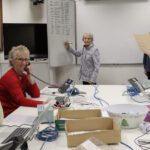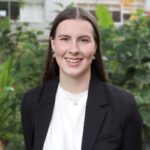Imagine walking into a university building and being surrounded by a profusion of interactive visual artworks created by data from the resident scientists and staff, electronically displayed on walls and ceilings.
That’s the reality in Curtin University of Technology’s new $116 million Resources and Chemistry Precinct. It’s a building that is not only functional, but also incorporates aesthetics and art directly into the core of its design.
The electronic artwork ― i-500 ― is embedded in the Precinct’s main foyer, and was developed by an international team headed by Curtin’s Director of the Centre for Research in Art, Science and Humanity, Associate Professor Paul Thomas.
He said the electronic art was generated by a series of computer algorithms that take source material from all over the building.
“Interactivity is one of the most important aspects of the design,” Associate Professor Thomas said.
“Using data created by the building’s users, the artwork displays stunning images on the ceiling of the main foyer and on the walls of a number of rooms and hallways, backed by evocative sounds.
“Research data can be sent for inclusion from within the building over the intranet to the main computer, allowing users to participate wherever they are.
“The system also uses motion sensors, capturing the movement of people in the building and incorporating these images into the artwork.”
i-500’s main display is powered by two 6,000 lumen projectors, which direct an evolving display onto the ceiling. Another 15 digital screens throughout the Precinct connect with the major artwork as echo nodes.
Contact: Associate Professor Paul Thomas; Department of Art; Curtin; 08 9266 3561; P.Thomas@curtin.edu.au


